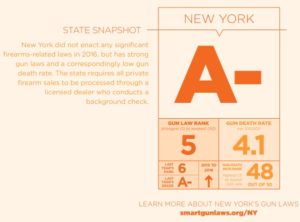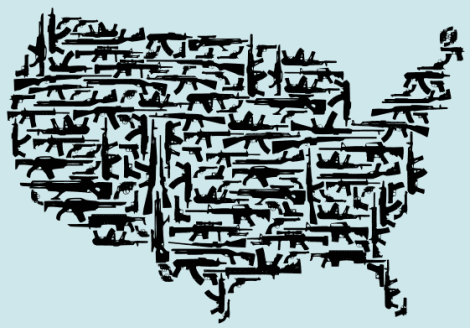This post was written by Donna Seymour, advocate and member of the St. Lawerence County Branch of AAUW-NYS as part of our PowHer the Vote 2017 campaign.
Gun violence is not just a crime and punishment or law and order problem. It is a public health crisis in our nation that affects every community and member of society from the youngest to the most senior. Women are far more at risk to be victims of fatal domestic violence, and guns play a significant role in that violence. Of the 1,591 female homicide victims in New York from 2003 to 2012, 522 were killed as a result of a domestic violence incident. Firearms accounted for the murders of 569 women in New York from 2002 to 2011.
A new FBI report says violent crimes such as shootings and robberies are on the upswing; 2016 makes the first time violent crime rose in consecutive years in more than a decade. It rose 4.1 percent in 2016 over 2015 rates. Homicides climbing 8.6 percent, violence increased 3.9 percent in 2015, and killings jumped by more than 10 percent.
The truth is, where you live in this country has an outsized impact on your safety. The Law Center to Prevent Gun Violence ranks states by the relative overall strength or weakness of their gun laws, where higher scores represent tougher gun laws. Laws considerations include background checks, dealer licensing, waiting periods and assault weapons bans. In a nutshell, the weaker the gun laws, the higher the death rate by guns in states.
State governments can do a lot to control access to guns and ensure the safety of their citizens. For example, in 2016 Connecticut adopted new laws to victims of domestic abuse from gun violence. That was after overhauling its existing gun laws in 2013 as result of the Sandy Hook school massacre. New York’s SAFE Act was also a response to Sandy Hook.
Politicians often hate to talk about their stand on guns and gun violence, but asking hard questions before an election can illuminate the difference between candidates on these important questions of public safety.
You can see a map of the country that will allow you to click on each state to review its score. Here is New York State’s scorecard from 2016:

Municipalities can also make changes. For the last four years, the state’s 17 biggest jurisdictions outside of New York City have participated in Gov. Andrew Cuomo’s GIVE — Gun-Involved ViolenceElimination — initiative. The program provides millions of dollars in funding, resources and training to the local agencies where 85 percent of upstate New York’s violent crime occurs. In 2017, GIVE provides $13.3 millions in technical assistance, training, equipment, and personnel to help communities reduce violent crime.
Nationwide in 2015, more than 1,600 women murdered by men and the most common weapon used was a gun. The report, titled “When Men Murder Women,” is compiled annually by the Violence Policy Center. What they found was that a gun in the home, generally bought to protect residents from intruders, was far more likely to be lethally used against a woman by an intimate partner, such as a boyfriend or husband. Report authors cite U.S. Department of Justice findings that show women are not only far likelier than men to be the victims of domestic abuse involving a weapon, they are attacked in their own homes more than any other location.
When you look closely at the FBI’s report on 2016 crime statistics, one statistic jumps out: shootings by handguns. In fact, 73 percent of 2017’s recorded homicides were committed with a gun, the highest percentage ever reported. Handguns are literally everywhere. The number of pistols produced rose from around 728,000 in 2004 to 4.5 million in 2016.
It is all too easy to get a handgun. In 32 states, gun owners can sell weapons in unregulated private sales that don’t require background checks. According to data collected by the Bureau of Alcohol, Tobacco, Firearms and Explosives, seven of the 10 calibers of gun found at crime scenes in 2015 are typically associated with handguns.
This availability of guns – particularly handguns – is important not just in violent crime, because more than 60 percent of people in this country who die from guns die by suicide. Suicide is the second-most common cause of death for Americans between 15 and 34, according to the Centers for Disease Control and Prevention. Across all ages, it is the 10th-most common cause of death, and caused 1.6 percent of all deaths in 2012.
Guns in the home make suicide easier and with greater chance for death in the first attempt.
“The high rate of gun suicides in the United States is not a new problem. Even in the 1980s and 1990s, whenviolent crime rates were much higher, gun suicides were still a more common cause of death than gun murders. But in recent years, as the gun homicide rate has flattened out, the gun suicide rate appears to be ticking back up slightly.”
The danger to children from unsecured guns is a clear and ever-present danger in too many homes. As one recent headline put it, A toddler has shot a person every week in the US for two years straight. A total of 668 children under the age of 12 were killed or injured by guns in 2016.
One recent Ohio State University study looked into this and found that exposure to gun violence does make a child more likely to pick up a gun and shoot it.
The study showed groups of kids, ages 8 to 12, different versions of the same movie. One had the gun scenes kept in, and one edited the gun scenes out. The children were then sent to a room to play where a real, unloaded gun was hidden amongst toys.
Stephen Cook, a pediatrician at the Golisano Children’s Hospital (in Buffalo, NY) says the results are interesting.
“When they looked at if kids found a gun, if kids had seen the movie with the gun violence, they picked up and held the gun for 53 seconds. Almost a minute. As opposed to the kids who saw the movie without gun violence. If they found the gun, they held it for about 11 seconds.”
The trigger of the gun had a sensor on it to track how often it was pulled.
The kids who saw the guns in the movie pulled 2.8 times, while kids who had seen the edited version with no guns pulled the trigger .01 times.
[Only] 32% of children in the study who found the gun reported it to the researcher.
Guns are a particular problem for teenagers. Syracuse, NY is one of 10 cities with the highest rates of teen shootings, Syracuse, a university town that once cranked out air conditioners and televisions, now has a poverty rate of 35 percent. Social media accelerates the threats, and the danger. Teenagers whose brains are years from fully maturing are roaming the streets with a gun in one pocket and a smartphone in the other. “A juvenile with a gun is a heck of a lot more dangerous than a 24- or 25-year-old with a gun,” said James Durham, the acting U.S. attorney based in Savannah.
In the absence of federal leadership on gun violence, the states and localities can – and should – take up this work of ensuring public safety. Organizations like Moms Demand Action For Gun Sense In America was created to demand action from legislators, state and federal; companies; and educational institutions to establish common-sense gun reforms in the wake of the Sandy Hook shooting.
The organization is a leading force for gun violence prevention, with chapters in all 50 states and a powerful grassroots network of moms that has successfully effected change at the local, state and national level. Their Be SMART program provides five simple steps that we can all take to prevent children from accessing guns.
In December 2013, Moms Demand Action partnered with Mayors Against Illegal Guns to unite a nationwide movement of millions of Americans working together to change the game and end the epidemic of gun violence that affects every community.
Find out what your community is doing to promote gun safety and what local candidates for elected office stand for when it comes to gun violence. You can step up on this issue to take action if your community is not making this a policy priority.
This post originally appears on Donna Seymour’s blog and can be viewed here.


